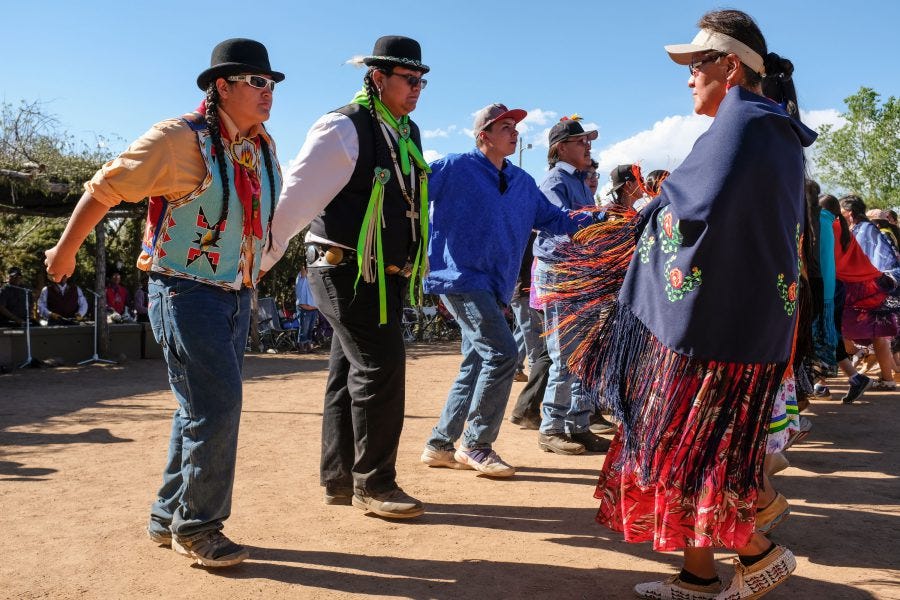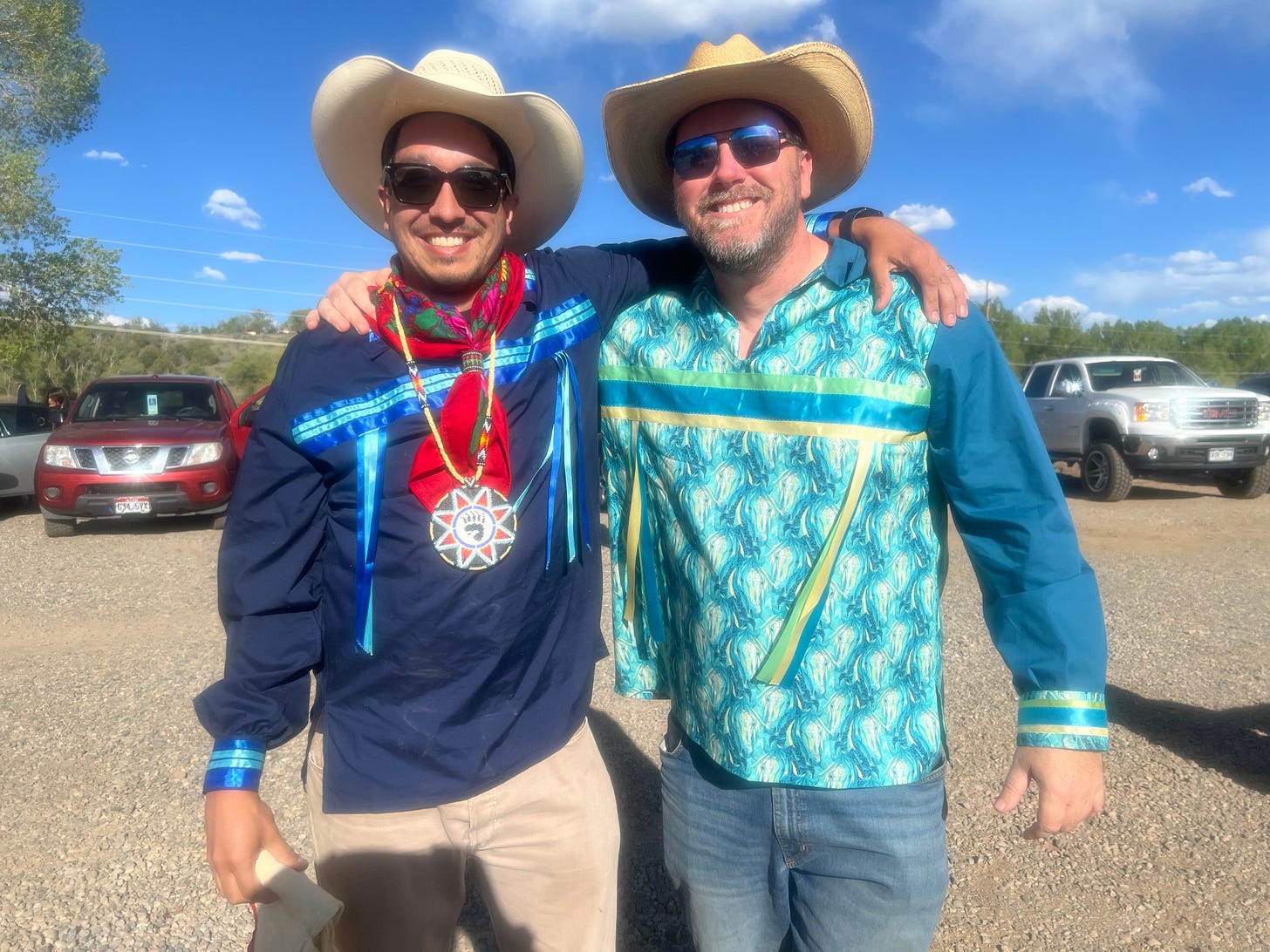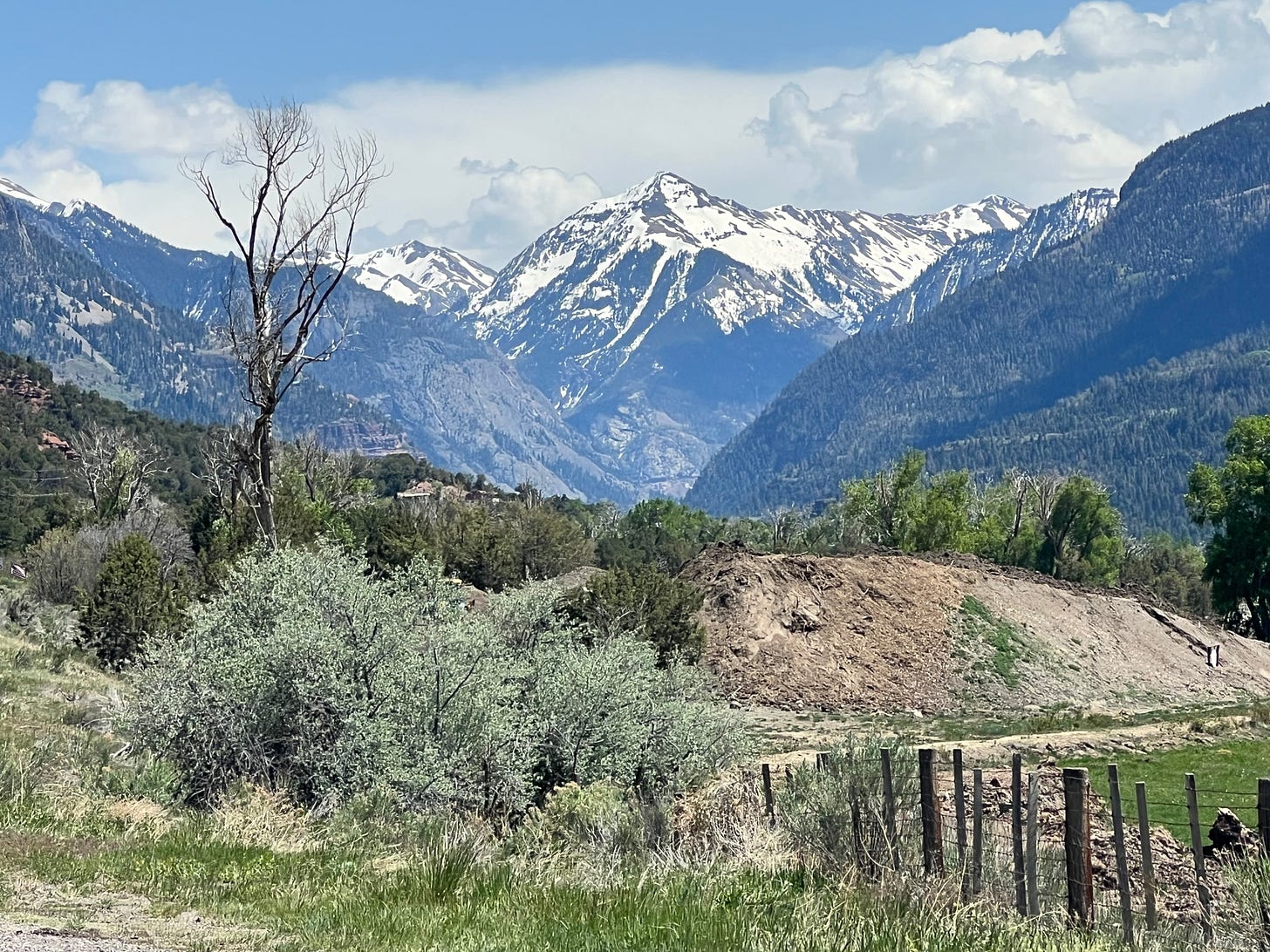A week ago I loaded up my luggage and headed west to Ignacio, Colorado, home of the Southern Ute Indian Tribe, where I would spend the following days visiting with Tribal Members at the 2025 Bear Dance. This was my second year attending the festivities and after conversations with Tribal Members who encouraged me to share more about my experiences with the Tribe, I decided to bring you with me as I recall the weekend.
First- a bit about the Southern Ute Indian Tribe. The Southern Utes are one of two resident tribes in Colorado (the other being the Ute Mountain Ute Tribe), with the two of them being joined by the Ute Indian Tribe of the Uintah and Ouray Reservation (located in eastern Utah). While their reservation is in southwestern Colorado, the Southern Utes are one of many tribes who call Colorado home including the Kiowa Tribe, Comanche Nation, Jicarilla Apache Nation, Cheyenne and Arapaho Tribes, Northern Cheyenne Tribe, Northern Arapaho Tribe, Pawnee Nation, and others (I’ll write more about my experiences with them with their permission and as I deem it appropriate but for now, know that I really love working with all these folks. You can learn more at the linked websites). The Southern Utes, like the other tribes I mentioned above, have both a beautiful and a hard history filled with love, kinship, and perserverance.
I had really been looking forward to this trip. Initially I had planned to miss it due to my friend (the dude is like my brother) Alan’s bachelor party, but a massive repair to my old truck’s engine forced me to stay behind. But I decided that I would make the most of the situation by returning to a place that I dearly love visiting. Besides, there is no better way to show the Tribes I give a damn than by just showing up. So I hopped in the Subaru, threw on Nick Offerman’s Gumption on Audible, and hit the road.
You’d think that perhaps a six hour drive through the mountains would be just what the doctor ordered. And perhaps that was true. But I am filled lately with frustration. Many of you know that I arrived here reeling from two breakups—one profession and the other personal—and saw this place as both a site of penance and maybe a new beginning. But in the nearly two years that I’ve been here, my angst has seemingly only grown. My friend (and amazing scholar) Andrew Frank told me to come out here and be at peace, and the writings of David J. Weber, Dan Flores, and James Brooks certainly invited the notions.
But despite their natural beauty, the mountains here just don’t speak to me, despite how much I’ve begged them to. I look to them for the answers I’ve been searching for and just can’t seem to find them. I feel my age creeping on me. I miss the ocean. My boys are forever away. And while I won’t talk about her here, there’s a woman I am smitten with. All of these thoughts whirling around my head like ghosts at the Haunted Mansion.
I’m not a patient man. Never have been. Nor am I religious. But time and time again I am reminded of what Comanche elder Lloyd Heminokeky told me—that Creator put me here to take care of this place for the Tribes and to be patient and trust in that. I probably think about that every day. So west I go.
I did have goals this trip. When I’m on the road I am constantly scanning the landscape to see what I can learn about these spaces. I imagine them before the Europeans arrived. And I wonder about what the herds of elk, mule deer, bison, and bighorn sheep looked like. I think about how these spaces changed and the changes that forced upon the people who call them home.
Because I am a historian of both the environment and of Native North America, I try to stop at as many locations as I can. James Brooks has served as a sort of Jedi Master for me out here—a beardless Obi-Wan if you will—pointing me to archaeological sites and fly fishing holes, with the latter perhaps being even more sacred (from a certain point of view). So one of my destinations this trip was to Chimney Rock National Monument, created by Puebloan ancestors about a thousand years ago. It’s located between Pagosa Springs and Durango and impossible to miss. Drive until you see the big rock that looks like chimney. A short hike and some elevation gain leads up to the great kiva constructed on the outcropping at about 7’620 feet. The site itself is pretty big—over seven square miles—and hosts over 200 homes. And the views are breathtaking.
After spending some time up here I headed over to Ignacio, where the Tribe hosts Bear Dance. Now, while I’ve been encouraged to share my experiences, I’m gonna tread lightly here because the last thing I’d want to do is get something wrong. So to describe what Bear Dance is, I’m going to share directly from the Tribe’s public website:
The Annual Ute Bear Dance which is held every spring is a social dance everyone enjoys. Origin of the Bear Dance can be traced back to the fifteenth century when the Spanish first came upon the Utes in the springtime. When the first thunder in the spring was heard, it was time for the Bear Dance.

According to some of the elders, this was usually around the middle of March. All the bands would come and set up camp and prepare for the dance. Many of the singers were ready to sing their songs which they had practiced or dreamed about during the winter months.
The original meaning of the Bear Dance has long dropped by the wayside as modern ways have intervened with the old methods of telling the meaning of the Bear Dance. It was the men who usually prepared the Bear Dance corral and any other functions connected with the Bear Dance. The women’s role was to prepare the family’s clothes that they were to wear during the dance. It was the role of the story teller to tell the family about the way of life and this was done in the winter time when the family was gathered around the camp fires.
The origin of the Ute Bear Dance relates the time when two brothers were out hunting in the mountains and as they became tired, they laid down to rest. One of the brothers noticed a bear standing upright facing a tree and seemed to be dancing and making a noise while clawing the tree. Ute legends or stories remember the time when the elders asked the hunters to go out and gather meat. As they were out hunting, they encountered some small people who ran into the rocks in the hills. They told the elders about them and the elders told them that they were called cliff dwellers which according to archaeologists were called Anasazi, the ancient ones. The one brother went on hunting while the other brother continued to observe the bear. The bear taught the young man to do the same dance and also taught the young man the song that went with the dance.
He told the young man to return to his people and teach them the dance and songs of the bear. The songs according to legends show respect for the spirit of the bear and the respect to the bear spirit makes one strong. After a long winter, everyone was ready to be outside. The Bear Dance was one way which people could release their tensions. The men and women, as they entered the corral, would wear some sort of plumes which at the end of the fourth and final day, they would leave on a cedar tree at the east entrance of the corral. As the Ute’s say, leaving the plume on the tree was to leave your troubles behind and start your life anew.
There’s a lot of reasons to attend Bear Dance: the spiritual described above, or just the interpersonal. I was eager to see my friends in the Tribe and looking forward to making new ones. And for me, it was hopefully the opportunity to pay respect just by showing up and dancing. And yes, I dance at Bear Dance. It’s so much fun. The dances are very easy (especially for guys since women lead), and they are such a release. Once you hop in the corral and start dancing, you don’t want to stop. I saw some folks go for HOURS.
I don’t have pictures of the event—the Tribe requests that non-Tribal Members refrain from taking photos—but my pal Garrett and I got this picture together. It was good to see him and his beautiful family. The shirts we are wearing are called ribbon shirts. I received mine last year as a gift from an elder who told me to wear it with pride, saying “when you wear this, we know that you know.”
If you’d like to see Bear Dance, you can visit yourself, or you can look online. Lots of Tribal Members have posted videos on TikTok and other social media, but I’m going to honor the spirit of the request by refraining from linking.
A lot of things were in my head over the three days I was on the reservation, mostly the same stuff that filled my mind as I was driving. But among other things, Bear Dance is a space where you are encouraged to let that stuff go, so every time I went in the corral to dance and brushed over the junipers, I focused on being a part of the community and worked to get out of my own head. On Monday during the feast (featuring some outstanding bison stew and frybread), I listened in on the laughs, and smiled as it rained, bringing some needed coolness to the heat of the day. Mostly I thought about the gift that it was to be invited to share in these days with this community. Even I had to admit that I am living a charmed life out here.
At the conclusion of each day I would leave the Dance grounds and pass by a simple sign that read “that which you left here when you entered the corral, do not pick back up.” It’s something I’ve had in my mind for the past week, along with Mr. Heminokeky’s words, and maybe even Yoda’s: Patience. You must learn patience.
I spent another day out west, touring the countryside, hoping for insight on Ute history and culture and maybe just a little tourism too (these spaces are phenomenally beautiful). I made it all the way north to Montrose, home of the Ute Museum and the final resting place of Chipeta, a Ute woman held in high regard and paid my respects. Standing at her grave, I told her that I never felt like I was doing enough, but hoped that she and the Tribe knew that my heart was with them.
And I listened in again to the mountains.
There’s a strange release that happens for me when I hit the reservation: I go completely at ease. It might sound strange coming from an academic, where battles rage over who can or cannot write certain types of history, but I’ve never felt anything but welcome in Indian Country. And this isn’t limited to Colorado. I can’t tell you how much love I’ve felt visiting Kiowa Country or Comanche lands, or meeting folks in the Cheyenne and Arapaho Tribes. And lord knows, I dearly miss hopping in the truck on Brighton Reservation in Florida with an elder known to everyone as “Dad” as we toured the cattle pastures and talked Seminole history. But here in Colorado, I’m reminded of a conversation with my friend Muzz. I’d once told him how much I missed my boys and how lonely I felt out here at times. His response: “Remember that you always have a home here with the Southern Ute.”
I suppose that if there’s one thing I want for non-Natives (and maybe Native folks too?) to take away from my writing, it’s just how welcome I’ve always felt in Indian Country. And I really hope to encourage you to do the same. Absolutely read Native history, but if you can, go to reservations or allotments. Visit the museums. Eat at the restaurants. Ask questions. Share smiles. Dance. It is how we heal.
Jason
If you liked this post and want to help contribute to Reckoning with Jason Herbert, please consider becoming a paid subscriber, which you can do below.






Thank you for this. It reminds me to make sure my agency asks permission to share things/videos online from our upcoming annual conference—in which we are having Cherokee dancers. Want to make sure we honor our hosts & are respectful.
So glad you've found healing where you are.